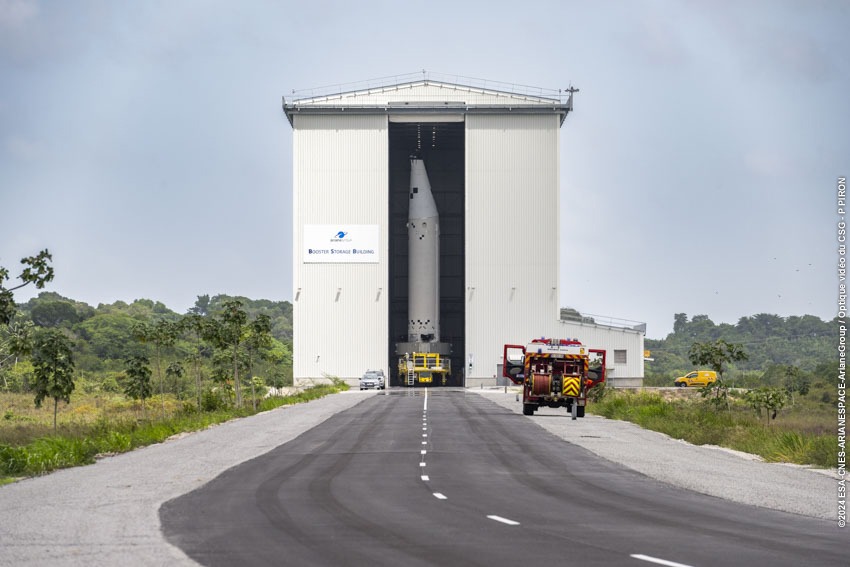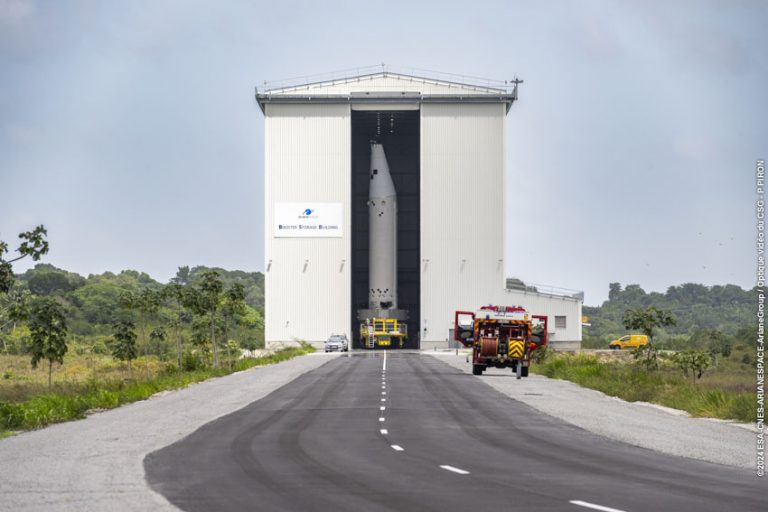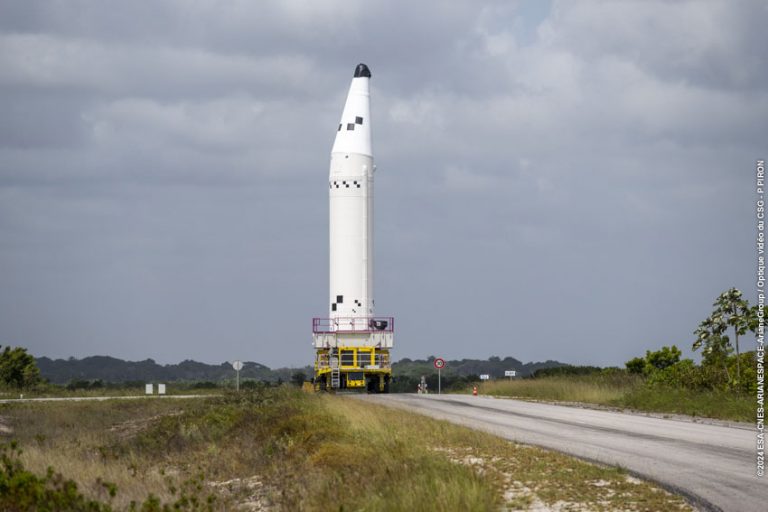First boosters for the BSB
03.12.2024

The new Booster Storage Building (BSB) at Europe’s Spaceport in Kourou, French Guiana, has now received its first two solid propellant boosters. These boosters, which will fly on the second Ariane 6 launcher, are the first in a long series. Let’s take a closer look at this new building.
Physical dimensions
To understand the scale of the building, you have to consider the dimensions of the boosters it will house – approximately 22 metres high and 3.4 metres in diameter. Technically known as Equipped Solid Rockets (ESRs), they consist of a rear cylindrical skirt, a P120C engine (the largest single-piece solid rocket motor in the world, also used as the first stage of the Vega-C launcher) and a large front skirt with a composite cone.
Designed to accommodate these boosters, the BSB is 60 metres long, 28 metres wide and 32 metres high, equivalent to a 10-storey building. It is Europe’s largest pyrotechnical equipment storage building. To ensure safe and precise handling operations, the boosters enter and exit the building on a system of pallets on rails, to reach the loader. Featuring 12 vertical docks, the BSB can house up to 12 boosters at the same time.
Another important factor is the very substantial floor load. The boosters and their pallets weigh up to 330 tonnes when the loader enters the building. And that’s without taking account of the weight of the building structure itself. The foundations required no fewer than 256 pylons, each measuring 12 to 23 metres in length and incorporating a 60-cm concrete slab to guarantee solidity and stability.
This gigantic building must also meet very stringent standards, since the BSB can store up to 1,900 tonnes of potentially explosive material. The designers applied the “avoid-minimise-compensate” approach, which includes both preventive and corrective measures to avoid environmental impacts, reduce the extent of any unavoidable impacts and compensate for those that are neither avoided nor reduced. Consequently, the BSB is situated 700 metres away from any other facility at the Spaceport.
Strategic dimensions
700 metres may seem a fair distance. But the BSB’s location was not chosen randomly. It is the final element of the booster zone in the launcher integration process. This new facility is rather like a logistics area, a buffer zone between the Booster Integration Building, where the boosters are produced one by one, and the Launch Zone, where they are used in twos or fours, depending on the version of Ariane 6. (You won’t need reminding that the versions are the medium-lift two-booster Ariane 62 and the heavy-lift four-booster Ariane 64.)
Depending on the ESR version or the angular position of the interface with the launcher, up to five different booster configurations are possible. And for more flexible logistics, two of the BSB’s docks are bi-compatible, able to house Ariane 6 boosters and Vega launcher first stages, thanks to a mechanical system capable of switching from one configuration to the other to adjust to the two different pallet types.
This flexibility is necessary to be able to increase the through-put rate. Having boosters immediately available means that more frequent launches are possible. Since the high requirements defined by the European Space Agency (ESA) for the development of Ariane 6 set a target capacity of two launches in two weeks, it must be possible to take up to eight boosters from stock. Thanks to the BSB’s operational flexibility, production is now scaled to supply the boosters needed for 12 launches a year. This is double the Ariane 5 launch rate. And with booster production rate aiming to triple, ramp-up is guaranteed.
Focus
The BSB was built by French Space Agency CNES, the prime contractor, on behalf of ESA and in collaboration with ArianeGroup, which is responsible for its operation.
With this building, ArianeGroup, which develops, produces and operates Ariane 6 together with its industrial partners, will have a permanent stock of boosters readily available for integration with the launcher’s central core on its launch pad.
The boosters that have just joined the BSB will fly on the first commercial flight of Ariane 6, marketed and operated by Arianespace, in the first quarter of 2025.


